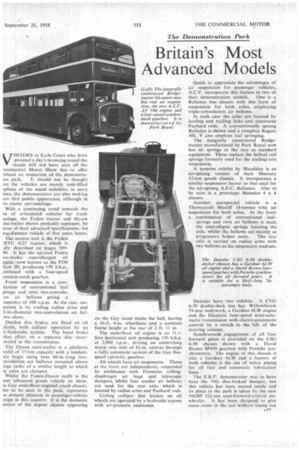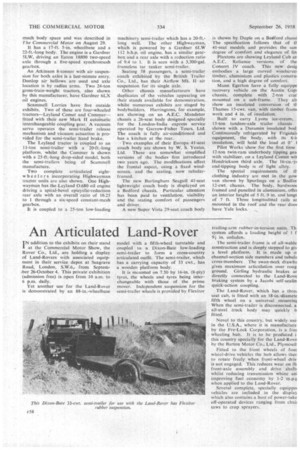The Demonstration Park
Page 211

Page 212

If you've noticed an error in this article please click here to report it so we can fix it.
Britain's Most Advanced Models
VISITORS to Earls Court who have planned a day's browsing round the stands will not have seen all the !ommercial Motor Show has to offer ,ithout an inspection of the dernonstra on park. It should not be thought iat the vehicles are merely tank-filled :plicas of the stand exihibits; in most ases, the demonstrators are also making telt first public appearance, although in us exotic surroundings.
With a continuing trend towards the se of articulated vehicles for trunk aulage, the Foden tractor and Dyson :mi-trailer shown probably represent, by irtue of their advanced specifications, the mg-distance vehicle of five years hence. The motive unit is the Foden :ETU 6/25 tractor; which is illy described on pages 28990. It has the uprated Foden No-stroke supercharged oil rigine;-now known as the FD6 lark III, producing 150 blip., ornbined with a four-speed onstant-mesh gearbox.
Front suspension is a cornination of conventional leaf prings and twin two-convoluon air bellows giving a -equency of 100 c.p.m. At the rear, susension is by trailing radius arms and 2-in."-diameter two-convolution air helms alone.
Dunlop disc brak.es are fitted on all /heels, with calliper operation by an if-hydraulic system. The hand brake Aces effect on a separate disc incororated in the transmission.
The Dyson semi-trailer is a platform todel of 17-ton capacity with a tandem* bogie using twin 66-in.-long two3nvolution air bellows mounted above arge tanks of a similar length to which 3 c axles are clamped.
Whilst the Foden-Dyson outfit is the iost advanced goods vehicle on show, le Guy underfloor-engined coach chassis, [so to be seen in the park, represents le present ultimate in passenger-vehicle esign in this country. It Is the domestic ersion of the export chassis appearing
on the Guy stand inside the hall, having a 16-ft. 4-in, wheelbase and a constant frame height at the rear of 2 ft. 11 in.
The underfloor oil engine is an 1.1.17 litre horizontal unit producing 150 b.h.p. at 2,000 r.p.m., driving an undershing worm rear axle of 8-1-in. centres through a fully automatic version of the Guy fivespeed epicYclic gearbox. • All wheels have air suspension. Those. at the front are independently suspended by wishbones with Firestone rollingdiaphragm air bags and telescopic dampers, whilst four similar air bellows are used for the rear axle, which is located by radius arms and Panhard rods.
Girling calliper' dise brakes• on all wheels are operated by a hydraulic system with air,pressure assistance.
Quick to appreciate the advantages of air suspension for passenger vehicles, A.C.V. incorporate this feature in two of their demonstration models. One is a Reliance bus chassis with this form of suspension for both axles, employing triple-convolution air bellows.
In each case the axles are located by leading and trailing links and transverse Panhard rods. A conventionally sprung Reliance is shown and a complete Regent Mk. V also employs leaf springing.
The integrally constructed Bridgemaster manufactured by Park Royal now has air springs at the rear as standard equipment. These replace the helical coil springs formerly used for the trailing-arm suspension.
A surprise exhibit by Maudslay is an air-sprung version of their Mercury I2-ton goods chassis. It incorporates a similar suspension. layout to that used for the air-sprung A.E.C. Reliance. Also to be seen is a prototype Matador 4 x 4 chassis.
Another unexpected vehicle is a Thornycroft Mastiff 14-tormer with air suspension for both axles. At the front a combination of conventional leafsprings and twin air bellows is used, the semi-elliptic springs locating the axle, whilst the bellows act mainly as progressive helper units. The rear axle is carried on radius arms with two bellows as the suspension medium.
Daimler have two exhibits. A CVG 6-30 double-deck bus has Willowbrook 74-scat bodywork, a Gardner 6LW engine and the Diamatic four-speed semi-automatic transmission with electro-pneumatic control by a switch to the left of the steering column.
Synchromesh engagement of all .four forward gears is provided on the CSG 6-30 chassis shown with a David Brown SP450 gearbox with 'Porsche synchronizers. The engine of this chassis is also a Gardner 6LW and a• feature of both vehicles is the use of nylon piping for all fuel and automatic lubrication lines,
The E.R.F. demonstrator was to have been the MG disc-braked dumper, but this vehicle has been moved inside and its place in the park is taken by the new 56GSF 121-ton semi-forward-control sixwheeler. It has been designed to give more room in the cab without losingtoo
much body space and was described in The Commercial Motor on August 29.
It has a 17-ft. 5-in. wheelbase and a 22-ft.-long body. The engine is a Gardner 5LW, driving an Eaton 18800 two-speed axle through a five-speed synchromesh gearbox.
An Atkinson 8-tonner with air suspension for both axles is a last-minute entry. Dunlop air bellows are used and axle location is by radius arms. Two 24-ton gross-train-weight tractors, also shown by this manufacturer, have Gardner 6LX oil engines.
Scammell Lorries have five outside exhibits. Two of these are four-wheeled tractors—Leyland Comet and Commer--fitted with their new Mark II autoinatie interchangeable coupling .gear. A vacuum servo operates the semi-trailer release mechanism and vacuum actuation is provided for the semi-trailer hand brake.
The Leyland tractor is coupled to an 11-ton semi-trailer with a 20-ft.-long platform, whilst the Commer is shown with a 25-ft.-long drop-sided model, both the semi-trailers being of Scammell manufacture. .
Two complete articulated eightwheeler s incorporating Highwayman tractor units are also shown. One Highwayman has the-Leyland 0.680 oil engine driving a spiral-bevel epicyclic-reduction rear axle with an overall ratio of 10.25 to I through a six-speed constant-mesh gearbox.
It is coupled to a 25-ton low-loading machinery semi-trailer which has a 20-ft.long well. The other Highwayman, which is powered by a Gardner 6LW 112 b.h.p, oil engine, has a similar gearbox and a rear axle with a reduction ratio of 9.4 to 1. It is seen with a 3,300-gal. frameless tar tanker semi-trailer.
Seating 58 passengers, a semi-trailer coach exhibited by the British Trailer Co., Ltd., has their Airflow Mk. It air suspension for its single axle.
Other chassis manufacturers have duplicates of the vehicles appearing on their stands available for demonstration, whilst numerous exhibits are staged by bodybuilders. Harringtons, for example, are showing on an A.E.C. Mandator chassis a 26-seat body designed specially for the London-India express service. operated by Garrow-Fisher Tours, Ltd. The coach is fully air-conditioned and has a kitchen at the rear.
Two examples of their Europa 41-seat coach body are shown by W. S. Yeates, Ltd. These are somewhat simplified versions of the bodies first introduced two years ago. The modifications affect the frontal aspect, using a fixed windscreen, and the seating, now tubularframed.
The new Burlingham Seagull 41-seat lightweight coach • body is displayed on a Bedford chassis. Particular attention has been paid to ventilation, visibility and the seating comfort of passengers and driver.
A new Super Vista 29-seat coach body is shown by Duple on a Bedford chassi The specification follows that of ti 41-seat models and provides the sari degree of comfort and elegance of lin Plaxtons are showing Leyland Cub an A.E.C. Reliance versions of the Consort IV coach. This new desig embodies a large curved windscreei timber, aluminium and plastics constru. tion, and a high degree of comfort.
Mann Egerton have a fully equippe recovery vehicle on the Austin Gips chassis, complete with 2-ton crar mounted on a sub-frame. They all show an insulated conversion of tt Thames 15-cwt. van, with timber frami work and 4 in. of insulation.
Built to carry Lyons ice-cream, 5-ton tandem-axle trailer chassis shown with a Duramin insulated hod: Continuously refrigerated by Frigidaii equipment, the body, with its 6-ii insulation, will hold the load at 0° I
Pilot Works show for the first time 12-ton twin-ram underbody tipping gea with stabilizer, on a Leyland Comet wit Hendrickson third axle. The 16-cu.-y, end-tipping body is of light alloy.
The special requirements of th clothing industry are met in the pow van shown by Spurlings on a .Bedfor 12-cwt. chassis. The bodV, hardwoot framed and panelled in aluminium, offei an interior height of 5 ft. 9 in. and lengt of 7 ft. Three longitudinal rails at mounted in the roof and the rear doot have Yale locks.












































































































































































































































































































































